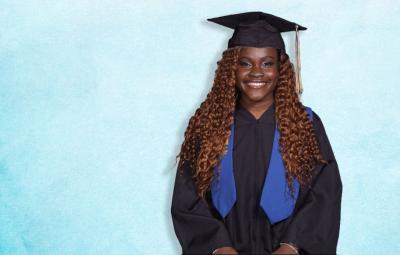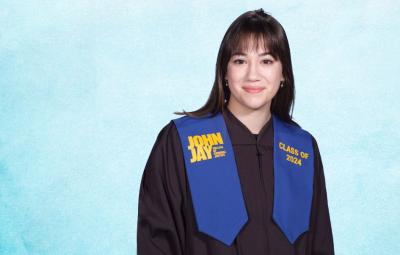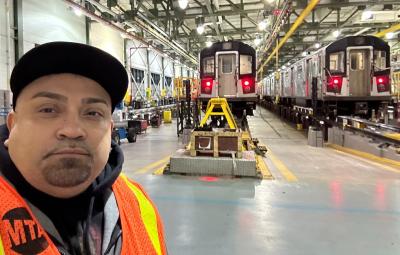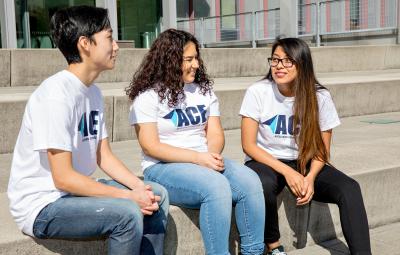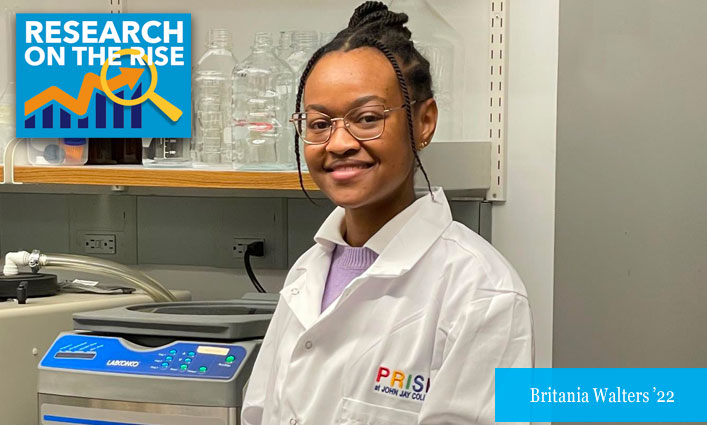
Research sits at the core of our mission to educate for justice,” says President Karol V. Mason. The remarkable research that our esteemed faculty, students, and alumni perform directly impacts our society and helps move the needle forward toward creating a more just world. Their empirical data reveals inconsistencies, pushes boundaries, and opens minds to a whole new way of thinking. Our “Research on the Rise” series aims to showcase the ongoing, upcoming, and noteworthy research happening right here at John Jay.
When the Black Lives Matter protests were at their height in 2020, international student Britania Walters ’22 noticed a disturbing trend among the crowd control methods being used by law enforcement. “They were using what’s called ‘less-lethal ammunition’ to keep the crowd under control. But protestors that were hit by this ammunition were emerging from the scene with real injuries,” explains Walters, a Program for Research Initiatives in Science and Math (PRISM) student. “Injuries sustained by protestors included contusions, lacerations, bruising, sprains, bone fractures and even brain injury.” Wanting to dig deeper into the matter, Walters began conducting research with her mentor and Forensic Science Professor Peter Diaczuk, Ph.D., with the goal of shining a light on the trauma caused by less-lethal ammunition, and one day help design a truly less-lethal form of ammunition. Their project recently won them recognition at the Northeastern Association of Forensic Scientists (NEAFS) Conference, where Walters was named the winner of the Peter R. De Forest Student Research Competition, Best Poster Presentation, Undergraduate Award. We sat down with Walters to learn more about her research and what she hopes it will accomplish.
Coming to John Jay
Moving to New York wasn’t really part of Walters’ future plans, but her love for the law and science drew her from her homeland of Jamaica to the doors of John Jay College. “My goal is to have a career that lets me combine my passion for science and the law. When I spoke to my mentor in Jamaica, and told her what I wanted for my future, she suggested I look at John Jay College and its Forensic Science major,” says Walters, whose concentration in the major centers on Criminalistics and Criminal Science. “In Jamaica, the Forensic Science major does not exist. After reading about John Jay College, PRISM, and its programming, I thought, this is where my community is. I belong at John Jay.”
“In Jamaica the Forensic Science major does not exist. After reading about John Jay College, PRISM, and its programming, I thought, this is where my community is. I belong at John Jay.” —Britania Walters
Being Mentored
Immersing herself in the College’s Forensic Science courses and PRISM program, Walters quickly jumped at the chance to collaborate and conduct research with dedicated faculty members who were experts in their respective fields. “Having a professor guide you in your academic career, especially on such a big and important research project, is really motivating,” says Walters. “For me, having Professor Diaczuk as my mentor on the less-lethal ammunition research has been an amazing experience. He’s an expert in the field and has conducted research and written numerous papers on weapons, bullets, and ballistics. What has been so powerful for me is that he listens to my ideas and really supports me. He’s the expert, but he’s not pushing his ideas on me. Instead, Professor Diaczuk gives me the room to think problems through and to explore what my ideas are. He’s been so encouraging throughout the research process.”
“Professor Diaczuk gives me the room to think problems through and to explore what my ideas are. He’s been so encouraging throughout the research process.” —Britania Walters
Finding a Research Topic
Diaczuk’s ability to let his student take the lead on their projects gave Walters an opportunity to really think deeply about the kind of research she wanted to conduct at John Jay. “At first it was overwhelming because I didn’t know what would be a good project. Then I started reading these stories about law enforcement using less-lethal ammunition for crowd control during Black Lives Matter protests,” recalls Walters. “The less-lethal ammunition is supposed to be a safer option because it’s not typically fatal, but what started to become clear to me was that the injuries due to this type of ammunition were causing real harm.” When she presented the idea to Diaczuk she was thrilled with his response. “He immediately said it was a great idea which was a real boost in confidence for me. I then began to do some of the preliminary research.” The initial work involved her looking at past research and literature, enabling Walters to lay the foundation for her project, but after finding very little information on less-lethal ammunitions, she turned her focus to news articles. “I was specifically looking for statistics, articles detailing incidents involving less-lethal ammunition, and where on the body the person got shot and what was the resulting injury. That data would help us see some of the damage caused by this less-lethal ammunition.”
“The less-lethal ammunition is supposed to be a safer option because it’s not typically fatal, but what started to become clear to me was that the injuries due to this type of ammunition were causing real harm.” —Britania Walters
Creating a Research Approach
The results from her preliminary work led to a big step in the research project, looking more closely at the weapons and the ammunition itself. “We decided to use the 12-gauge less-lethal baton shotshell during our research so we could compare it with the lethal ammunition,” explains Walter. After weighing the ammunition, Walters and Diaczuk cut open and inspected the components of both lethal and less-lethal ammunition, learning what similarities they shared, where they differed, and how those differences in design can strengthen or lessen the ammunition’s impact.
Presenting her Research at NEAFS
While the pandemic slowed some of Walter’s initial progress, she still made impressive headway and with Diaczuk’s encouragement, presented her project summary, findings, and future research goals during the NEAFS Conference earlier this month. “Honestly, I would not have presented if it wasn’t for Professor Diaczuk. He pushed me to submit my abstract and reminded me that while my research is still ongoing, we’ve done valuable work and should share it with others.” Presenting virtually, Walters admits she felt nervous about answering questions and explaining her research to professionals. “I find that at times it’s hard for me to explain my research to people, mostly because it’s still not finished, but they understood the situation completely,” says Walters. “Being able to present our work thus far was an honor and I was grateful for the opportunity. Then when I learned I was the Peter R. De Forest Student Research Competition, Best Poster Presentation, Undergraduate Award winner, I was so moved. It’s good to know that our hard work is appreciated.”
Continuing the Research
The next step of the research will see Walters and Diaczuk investigate the variables that can change the outcome when deploying less-lethal ammunition—this includes the angle at which the ammunition is shot, the distance from the shooter to the target, and where on the body the ammunition hits. “Our hope is to acquire a large number of baton rounds and then test what angles and distances prove to be the least harmful when it comes in firing less-lethal ammunition,” says Walters. “We’ll be shooting less-lethal projectiles at simulated body tissue, which is a ‘body’ made of ballistic gelatin, a skin simulant, and a t-shirt. We’re going to shoot from different distances and angles to see which one causes the least amount of harm. Once that data is collected, we’ll compare it to trauma caused by lethal projectiles on a ballistic gelatin setup. The hope is that our research will lead to the creation of safer and truly less-lethal ammunition.”
“The hope is that our research will lead to the creation of safer and truly less-lethal ammunition.” —Britania Walters
Thinking of Her Future
Looking back at her experience at John Jay, Walters can’t help but be reminded of all the positive ways research has impacted her life over the last few years. It introduced her to a course of study not readily available in Jamaica, connected her to faculty mentors that value her input, and acquainted her with industry experts who are excited about her work. It also revealed her true passion for research and gave her a clearer view into what she wants her future to look like. “Before this research on less-lethal ammunition and my work with Professor Diaczuk, I was unsure about what direction I wanted to go after graduation. But now I know what I want,” says Walters. “I want to go to graduate school to earn my master’s degree and then my Ph.D. I want to work in a crime lab and conduct research on the side. I want to be a leader in the field like Professor Diaczuk. I want to be the one called on to be an expert witness on firearms and ballistics for criminal cases. And, because of John Jay, I know that with hard work and dedication all my goals are achievable.”
